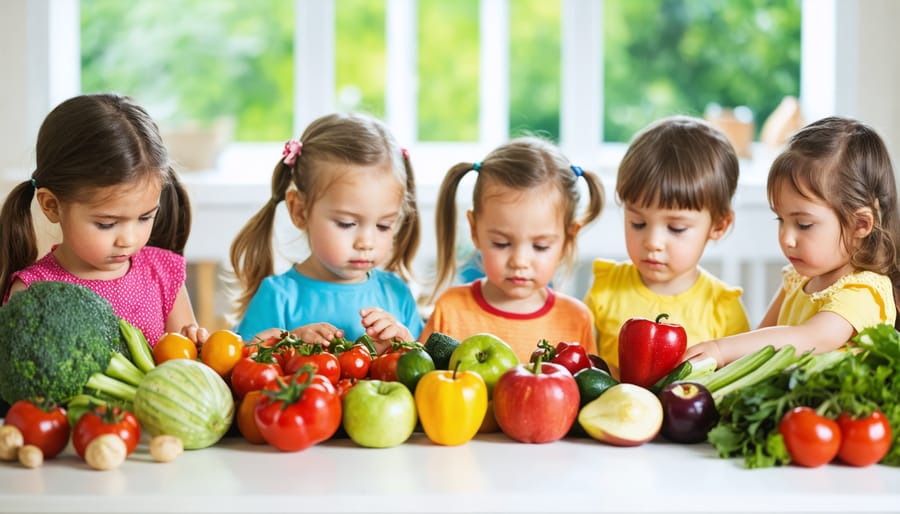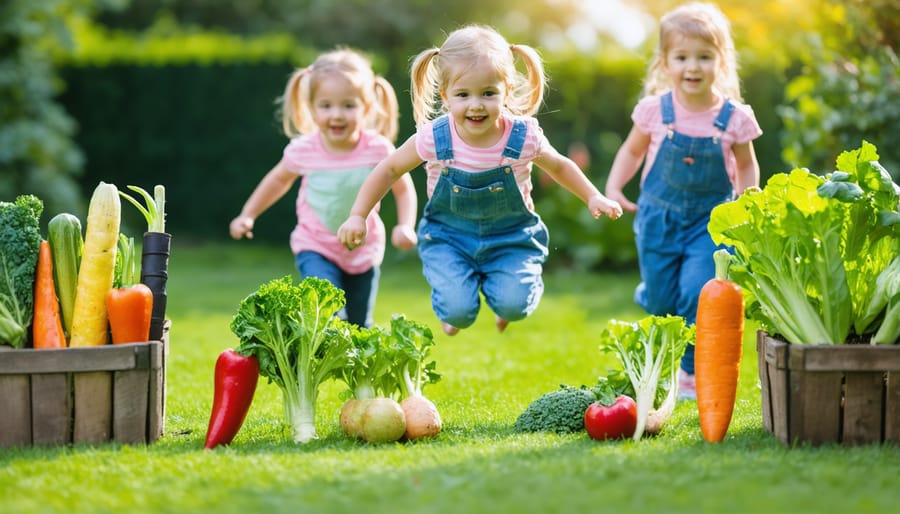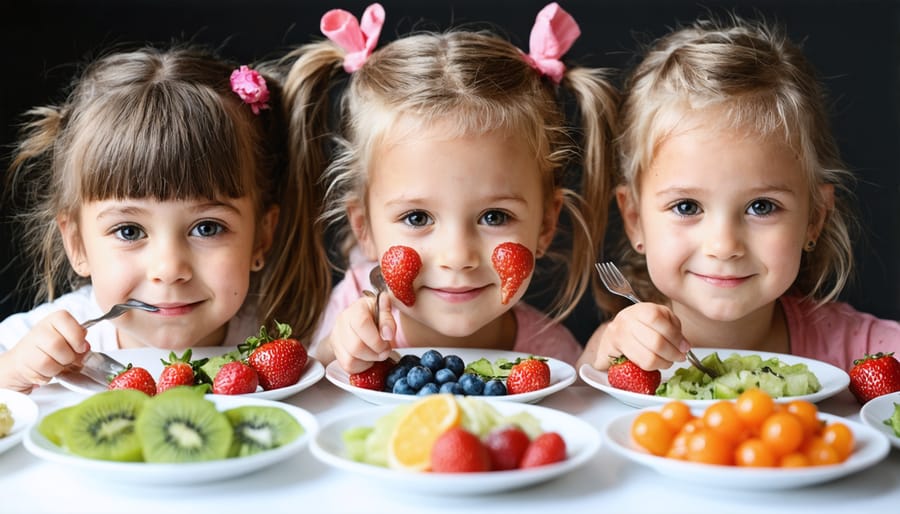Transform your preschooler’s understanding of health and nutrition through playful, hands-on activities that make learning delicious and movement irresistible. Getting young children excited about healthy choices doesn’t require complex lesson plans or expensive materials – it starts with turning everyday moments into opportunities for discovery.
Create a colorful “rainbow plate” activity where children sort fruits and vegetables by color, learning about different food groups while developing fine motor skills. Let them help plant a small herb garden, watching their food grow from seed to table, or engage them in simple food preparation tasks like washing vegetables or mixing ingredients for healthy snacks.
Physical activity naturally complements nutrition education, especially when it’s disguised as play. Turn grocery shopping into a movement game by having children hop to find green vegetables or stretch tall to point out healthy proteins. Set up obstacle courses that mimic different foods’ journeys from farm to table, combining learning with active play.
By making health and nutrition an interactive, joyful experience, we lay the foundation for lifelong healthy habits. These early experiences shape not just what children know about nutrition, but how they feel about making healthy choices – turning education into everyday adventure.
Making Food Fun: Interactive Learning Activities
Color-Based Food Exploration
Make learning about healthy foods exciting by turning it into a colorful adventure! Encourage your preschoolers to explore fruits and vegetables through the rainbow of colors nature provides. Start by creating a simple color chart with your little ones, using pictures of different foods for each color category.
For red foods, introduce strawberries, apples, and tomatoes. Yellow can include bananas and corn, while orange features carrots and sweet potatoes. Green opens up a world of possibilities with broccoli, spinach, and peas. Don’t forget purple foods like eggplants and grapes!
Turn this into an interactive game by having children sort plastic food toys or pictures into color groups. You can also create a weekly “color challenge” where kids try to eat foods of a specific color each day. Make it more engaging by asking them to draw pictures of their favorite foods in each color category.
For added fun, organize a “rainbow tasting party” where children can sample different colored foods while learning about their nutritional benefits in kid-friendly terms. Remember to praise their willingness to try new foods and celebrate their discoveries!

Sensory Food Play
Engaging preschoolers in sensory food exploration is a wonderful way to develop positive mindful eating habits and reduce food anxiety. When children can touch, smell, and safely taste different foods in a pressure-free environment, they become more open to trying new things.
Start with simple activities like creating faces using different fruits and vegetables. Let your preschoolers handle smooth apple slices, bumpy orange peels, and fuzzy kiwis while discussing their textures. This hands-on approach helps children develop a natural curiosity about different foods.
Set up “mystery boxes” containing various safe-to-touch foods and let children describe what they feel. Use familiar items like pasta shapes, rice, or dried beans. This activity builds vocabulary while making food exploration fun and engaging.
Encourage gentle food investigation by having children close their eyes and guess different foods by their smell. Use aromatic fruits like strawberries or oranges, and herbs like mint or basil. This helps develop their sensory awareness and makes the connection between smell and taste.
Remember to maintain a positive, no-pressure atmosphere during these activities. Some children may initially be hesitant to touch or taste new foods, and that’s perfectly normal. Focus on making the experience enjoyable rather than forcing participation.
Always supervise these activities and be mindful of any food allergies in your group. Choose age-appropriate foods that are safe for handling and tasting, and teach proper hand hygiene before and after food play.
Movement Games That Teach Nutrition
Food Group Relay Races
Turn nutrition education into an exciting physical activity with this engaging relay race that helps preschoolers learn about food groups while staying active. This game not only reinforces healthy eating concepts but also helps children develop a positive emotional connection with food.
Set up four baskets or boxes, each labeled with a different food group: fruits, vegetables, grains, and proteins. Place picture cards of various foods in a pile at the starting line. Divide children into small teams and have them line up behind the starting point.
When you say “go,” the first child from each team picks up a food card, runs to the appropriate basket, and places it in the correct food group. They then run back and tag the next teammate in line. The game continues until all cards are sorted.
Make it more interactive by asking children to act like their favorite food as they run – hop like an apple, waddle like a piece of bread, or stretch tall like a carrot! This adds an imaginative element that keeps young ones engaged while learning.
Remember to celebrate everyone’s participation and use this opportunity to discuss why different foods belong in their respective groups. You can adjust the difficulty by using more complex food items or adding dairy as a fifth category for older preschoolers.
Garden-Inspired Movement Activities
Transform your garden or classroom into an active learning space with these delightful movement activities that teach children about how plants grow while keeping them physically engaged. Let’s explore some fun ways to combine exercise with garden education!
The “Growing Seed” stretch is a favorite among preschoolers. Have children curl up small like seeds, then slowly stretch upward as they “grow” into tall plants, reaching their arms high toward the sunshine. This activity helps develop body awareness and flexibility.
Create a “Garden Obstacle Course” where children can hop like bunnies between plant rows, crawl like caterpillars under imaginary leaves, and stretch like vines reaching for support. Add watering can carries to build arm strength and practice coordination.
“Harvest Helper” exercises turn picking movements into fun stretches. Children can practice squatting to “pick” low-growing vegetables, reach up high for “tree fruits,” and twist gently from side to side like corn stalks in the breeze.
The “Pollinator Dance” gets hearts pumping as children flutter like butterflies, buzz like bees, and flit from flower to flower. This activity teaches about plant reproduction while encouraging cardiovascular exercise.
For rainy days, try “Indoor Garden Yoga,” where children can pose as different plants and garden creatures. Tree pose becomes a growing seedling, while cobra pose can represent a worm helping the soil.
Remember to make these activities inclusive and adaptable for all ability levels. The goal is to create joyful movement experiences that connect children with nature while supporting their physical development.

Creative Kitchen Projects
No-Cook Healthy Snacks
Getting your preschooler involved in making healthy snacks is a wonderful way to teach them about nutrition while building their confidence in the kitchen. Here are some simple, safe options that little hands can help prepare:
Fruit and Yogurt Parfaits
Let your child layer vanilla yogurt with their favorite fruits in a clear cup. They can add whole grain cereal for extra crunch. This activity teaches colors, counting, and basic layering skills.
Rainbow Veggie Boats
Use cucumber or celery sticks as “boats” and fill them with cream cheese or hummus. Children can decorate their boats with colorful vegetable toppings like cherry tomatoes, carrots, or bell peppers.
Apple “Cookies”
Have your child help slice apples into rounds (with supervision), then let them spread peanut butter or sunbutter on top. They can decorate with raisins, granola, or mini chocolate chips.
Banana Sushi
Let your preschooler spread peanut butter on a whole grain tortilla, place a banana in the center, and help them roll it up. They can then help slice it into “sushi” pieces (with adult assistance).
Trail Mix Creation Station
Set out small bowls of healthy ingredients like whole grain cereals, dried fruits, and seeds. Let your child measure and mix their own special blend.
Remember to always supervise kitchen activities and be mindful of any food allergies in your group.
Food Art Projects
Food art projects offer a delightful way of building positive associations with healthy foods while sparking creativity in preschoolers. These hands-on activities make nutritious eating fun and memorable for little ones.
Start with simple fruit and vegetable faces on a plate. Let children arrange cucumber slices for eyes, cherry tomatoes for a nose, and carrot sticks for a smile. They’ll love creating different expressions while learning about various produce.
Try making “butterfly snacks” using celery sticks as the body, filled with nut butter or cream cheese, and decorating with colorful fruit slices as wings. This activity teaches food groups while developing fine motor skills.
Another engaging project is “rainbow plates,” where children sort foods by color. Challenge them to create a rainbow using red strawberries, orange mandarin segments, yellow bell peppers, green grapes, and blue blueberries. This teaches color recognition while introducing different healthy options.
“Garden scenes” are another creative option – use broccoli florets as trees, shredded carrots as grass, and cherry tomatoes as flowers. This activity helps children understand where different foods come from while encouraging artistic expression.
Remember to make these activities pressure-free and enjoyable. The goal is to foster curiosity about healthy foods through play and creativity.

Making It Stick: Building Healthy Habits
Reward Systems and Progress Charts
Encouraging healthy habits in preschoolers becomes more effective when combined with positive reinforcement. Taking a mindful approach to rewards helps children develop a lasting positive relationship with healthy choices.
Create a colorful chart where children can place stickers or stamps for trying new fruits and vegetables, participating in physical activities, or choosing water over sugary drinks. Keep the focus on effort and exploration rather than perfection. For instance, award stars for tasting new foods, regardless of whether they liked them.
Consider using a “rainbow chart” where kids track eating fruits and vegetables of different colors throughout the week. This makes nutrition education visual and exciting while teaching color recognition. Another effective approach is the “active animals chart,” where children mimic different animal movements and earn corresponding stamps.
Remember to celebrate small victories and avoid using food as rewards. Instead, offer meaningful incentives like extra playtime, choosing the next activity, or special helper roles. This reinforces the intrinsic value of healthy choices while making the journey fun and engaging for your little ones.
Family Involvement Ideas
Bringing nutrition education into your home creates lasting healthy habits and strengthens family bonds. Make mealtime a family adventure by involving your preschooler in meal planning and grocery shopping. Let them pick out new fruits or vegetables to try each week, and create a fun chart to track their “food explorer” discoveries.
Turn cooking into family bonding time by giving your little one age-appropriate tasks like washing vegetables, stirring ingredients, or arranging items on plates. Create special “cooking helper” aprons together and celebrate their contributions to family meals.
Start a small herb garden or windowsill vegetable patch that your child can help tend. This connects them to where food comes from and makes them more likely to try foods they’ve helped grow.
Make weekend activities nutrition-focused by visiting farmers’ markets, picking fruits at local orchards, or having picnics with healthy homemade snacks. Create photo albums of these food adventures to reinforce positive memories around healthy eating.
Remember to model good eating habits yourself – children learn best by example. Share family meals whenever possible, turning off screens and focusing on meaningful conversation while enjoying nutritious food together.
Teaching preschoolers about health and nutrition doesn’t have to be complicated – it’s all about making learning fun and engaging. Through the activities we’ve explored, young children can develop positive relationships with food, exercise, and their own wellbeing in ways that feel natural and enjoyable.
Remember that every child learns differently, so don’t be afraid to adapt these activities to suit your preschoolers’ interests and abilities. The key is consistency and positive reinforcement. When children participate in regular nutrition education through hands-on experiences, they’re more likely to develop healthy habits that last a lifetime.
Keep activities short, playful, and interactive. Whether it’s creating a rainbow fruit salad, dancing to nutrition-themed songs, or playing active food-group sorting games, make sure the focus stays on fun while learning happens naturally. Celebrate small victories and encourage curiosity about healthy foods and movement.
Parents and educators, you play a crucial role in shaping children’s attitudes toward healthy living. By incorporating these activities into your daily routines, you’re helping preschoolers build a strong foundation for lifelong wellness. Continue to model healthy choices, maintain open conversations about nutrition, and most importantly, keep the joy in learning about health and wellness.
Remember, building healthy habits is a journey, not a race. Every positive experience with nutritious foods and physical activity brings your preschoolers one step closer to a healthier future.



